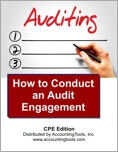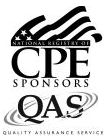How to Conduct an Audit Engagement (CPE Course)
CPE Credit: 17 hours
Course Type: Downloaded PDF materials with online test
Price (with PDF Textbook): $120
Course Description
The auditor needs to conduct audits as efficiently and thoroughly as possible. In How to Conduct an Audit Engagement, we describe every aspect of an audit engagement, including the engagement letter, audit planning, audit sampling, audit evidence, fraud considerations, audit documentation, auditor reports, and much more. Throughout, there is an emphasis on the practical aspects of auditing. This course is derived in part from the Statements on Auditing Standards.
Author: Steven Bragg
Course Number: AU1024
Table of Contents
Chapter 1. The Client Acquisition Process
Chapter 2. Audit Objectives
Chapter 3. The Audit Process
Chapter 4. Engagement Letters
Chapter 5. Planning Audit Procedures
Chapter 6. Audit Sampling
Chapter 7. Audit Evidence
Chapter 8. Analytical Procedures
Chapter 9. Auditing Accounting Estimates
Chapter 10. Fraud Considerations
Chapter 11. Written Representations
Chapter 12. Going Concern Considerations
Chapter 13. Law and Regulation Considerations
Chapter 14. Using the Work of Others
Chapter 15. Audit Documentation
Chapter 16. Subsequent Events
Chapter 17. Related Parties
Chapter 18. Auditor Independence
Chapter 19. Auditor’s Reports
Chapter 20. Communications with Those Charged with Governance
Chapter 21. Communicating Internal Control Matters
Chapter 22. Quality Control Issues
Learning Objectives
Recognize the situations in which engagement risk increases.
Identify the situations in which an auditor could be charged with negligence.
Specify how to reduce audit risk to an acceptably low level.
Define a material misstatement.
Identify detection risk reduction strategies.
Specify how to determine when an audit objective has been achieved.
Recognize the different planning documents used in an audit.
Recognize the activities involved in gaining an understanding of the client.
Identify the circumstances under which a client’s accounting policies are a particular concern.
Identify the circumstances under which the auditor might use a client’s internal audit function.
Specify the different types of risk assessment procedures.
Describe the use of prior audit information by the auditor.
Recognize the different types of risks of material misstatement.
Specify the indicators of risks of material misstatement.
Recognize the various types of benchmarks that could be used as a materiality threshold.
Identify the types of service auditor reports on the effectiveness of a service organization’s controls.
Identify the contents of and best practices for an engagement letter.
Specify how tests of controls can reduce the need for substantive procedures.
Specify the uses to which computer assisted audit techniques can be put.
Identify the characteristics of nonstatistical sampling.
Recognize the components of audit risk.
Specify the nature of attribute sampling.
Describe how to use a sampling unit to maximize sampling efficiency.
Specify the nature of the tolerable rate of deviation.
Recognize how sequential sampling works.
Cite the proper documentation for tests of controls.
Identify the various indicators of fraud.
Specify the situations in which a misstatement should not be extended to an entire population.
Recognize the various alternative sources of audit evidence.
Describe the nature of the relevance and reliability concepts.
Identify the audit procedures pertaining to the audit of cash.
Specify the audit procedures pertaining to the audit of investments.
Recognize the audit procedures pertaining to the audit of receivables.
Identify the audit procedures pertaining to the audit of inventory.
Identify the audit procedures pertaining to the audit of fixed assets.
Specify the audit procedures pertaining to the audit of liabilities.
Recognize the phrases used by attorneys to indicate the outcomes of lawsuits.
Specify the audit procedures pertaining to the audit of equity.
Identify the situations in which negative and positive confirmations should be used.
Recognize the situations in which analytical procedures should be used.
Recognize the issues that can impact the precision of an analytical procedure.
Identify the precision levels of the various types of audit testing.
Identify the probable causes of unexpected variances.
Describe the situations in which an accounting estimate may have high estimation uncertainty.
Identify the components of the fraud triangle.
Specify who is responsible for fraud prevention and detection.
Recognize the pressures for a client to falsify its financial statements.
Describe the appropriate staffing for an engagement where the presence of fraud is suspected.
Identify the characteristics of fraudulent journal entries.
Specify the signs that a document has been altered.
Specify who should sign off on the written representations document.
Define the unique characteristics of the liquidation basis of accounting.
Identify the types of laws or regulations that could impact a client’s financial statements.
Recognize the procedures that may be used by a client to ensure its compliance with laws and regulations.
Recognize how one might identify which components are significant at the group level of a group audit.
Cite the circumstances under which there could be a risk of material misstatement in a group audit.
Specify the situations in which an auditor may elect to use the work of a specialist.
Recognize which documents should be included in audit working papers.
List the auditor’s objectives in relation to subsequent events.
Identify the indicators of a related party relationship.
Recognize the characteristics of an arm’s length transaction.
Recognize the various elements of independence for the auditor.
Cite the different types of financial interest that an auditor may have in a client.
Identify the circumstances under which an employment arrangement could impact an auditor’s independence.
Recognize the issues for an auditor when accepting a gift from a client.
Specify the different types of audit opinions.
Identify the situations in which it may be difficult to identify those charged with governance of a client.
Identify the different designations for control weaknesses and deficiencies.
Recognize the situations in which an engagement team relies on a system of quality control in the conduct of an audit.
Level: Overview
Instructional Method: QAS Self-Study
NASBA Category: Auditing
Prerequisites: None
Advance Preparation: None
Latest Review Date: March 2025
Program Registration Requirements: Click on "Purchase Course" near the top of this page to pay for and access the course. You will then be able to download the course as a PDF file, then take an on-line examination, and then download a certificate of completion if you pass the examination.
Program Refund Policy: For more information regarding administrative policies concerning complaints, refunds, and other matters, see our policies page.
AccountingTools, Inc. is registered with the National Association of State Boards of Accountancy (NASBA) as a sponsor of continuing professional education on the National Registry of CPE Sponsors. State boards of accountancy have the final authority on the acceptance of individual courses for CPE credit. Complaints regarding registered sponsors may be submitted to the National Registry of CPE Sponsors through its website: www.nasbaregistry.org.
The NASBA sponsor identification number for Accountingtools, Inc. is 115881.
AccountingTools is an IRS Approved Continuing Education Provider. We are compliant with the requirements for continuing education providers (as described in sections 10.6 and 10.9 of the Department of Treasury’s Circular No. 230 and in other IRS guidance, forms, and instructions). Our IRS Approved Continuing Education Provider number is 72821.


